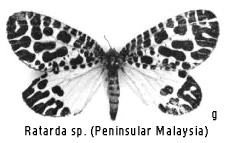|
This family contains eight described species and three undescribed
arranged in two genera, all from the Oriental Region. Three are known from the
N.E. Himalaya, one from Taiwan, three from Borneo and one, Callosiope
banghaasi Hering, is known only from undated material (Hering 1925). There
are single specimens of undescribed species from Peninsular Malaysia and Sumatra
(Fig. 68) and three of one from Burma in the BMNH.
|

|
 |
The species are delicate cossoids with fore- and hindwings of
approximately equal area and with distinctive rounded margins. In the forewing,
vein CuP is weak to absent so there is only one strong anal vein. The fore- wing
pattern is characteristically of white blotches on dark blackish brown, or spots
of the latter colour on a ground of white, yellow or dull red.
All the specimens in the BMNH are female as are those referred to by
Hering. The antennae are weakly bipectinate over the whole length. The genitalia
(Fig. 88) show marked similarity to those of the Metarbelidae.
|

|
Nothing is known about the biology of the species and they are evidently
very rare in nature. One Bornean specimen was taken at light but the single
specimen from Peninsular Malaysia was probably taken (by W.A. Fleming) flying by
day. The similarity of the female structure to that of the Metarbelidae suggests
similar oviposition behaviour, so the Ratardidae may also be bark feeders as
larvae.
The Bornean species, all described by Hering (1925), are:
Ratarda mora Hering
(Fig. 68). This is a black species with circular white spots on
the forewings, some slightly larger than in the specimen illustrated of the next
species. Two specimens are known from the island of Labuan, taken by Waterstradt.
Ratarda flavimargo Hering (Plate 4). The wings are pinkish grey with
black markings between the veins; the margins of both wings grade to yellow. The
female holotype was also taken by Waterstradt in Labuan. A second female was
taken by Lt. Col. Allen in rain forest at Labi in Brunei in 1981.

Ratarda flavimargo ♀ |
Ratarda melanoxantha Hering (Fig. 68). This species is slightly smaller
than the other two, the wings a mottled yellow with a small basal black zone on
the forewing and a deeper one, extending over half the wing, on the hind- wing.
The unique female was taken by Waterstradt on G. Kinabalu.
|






